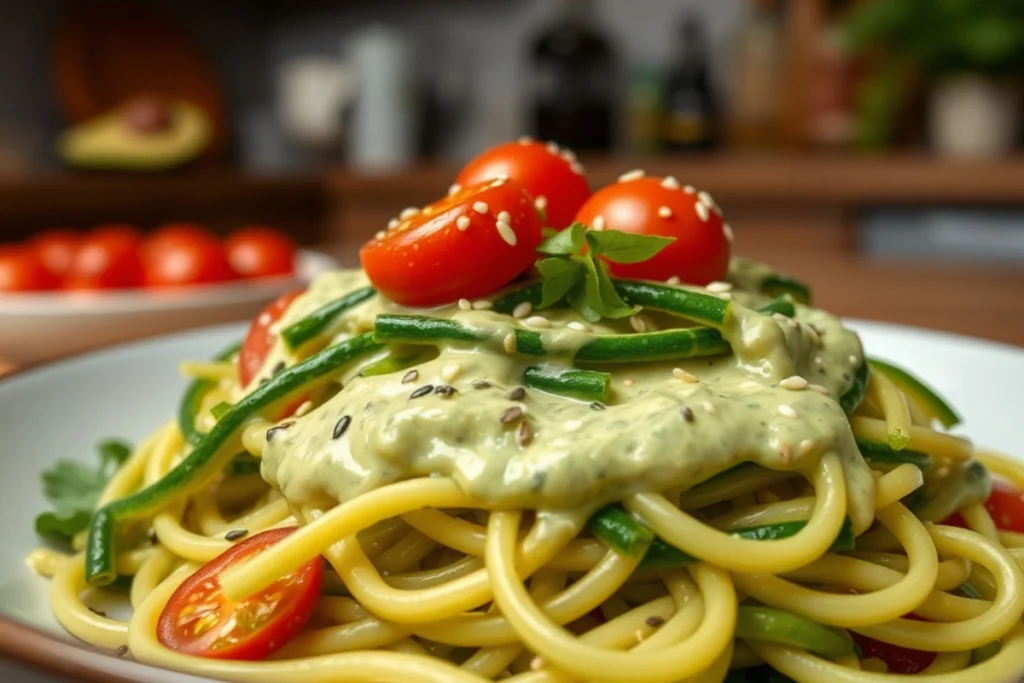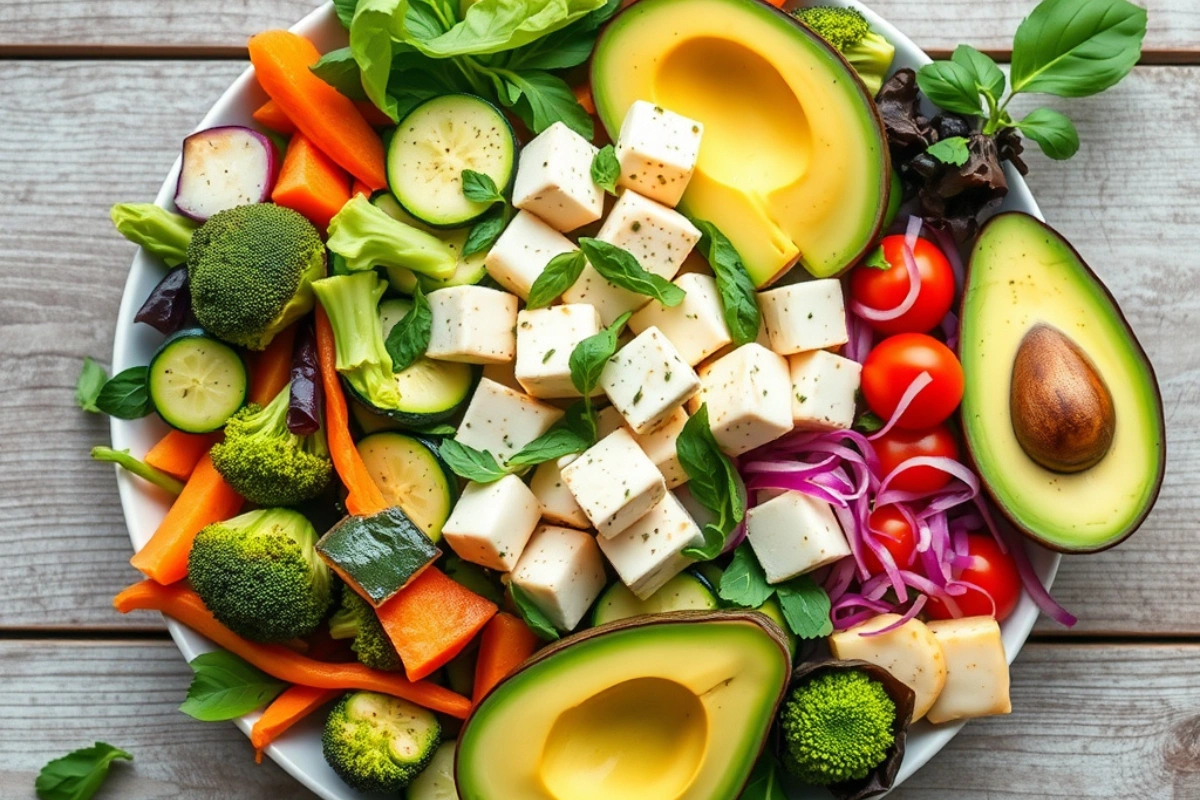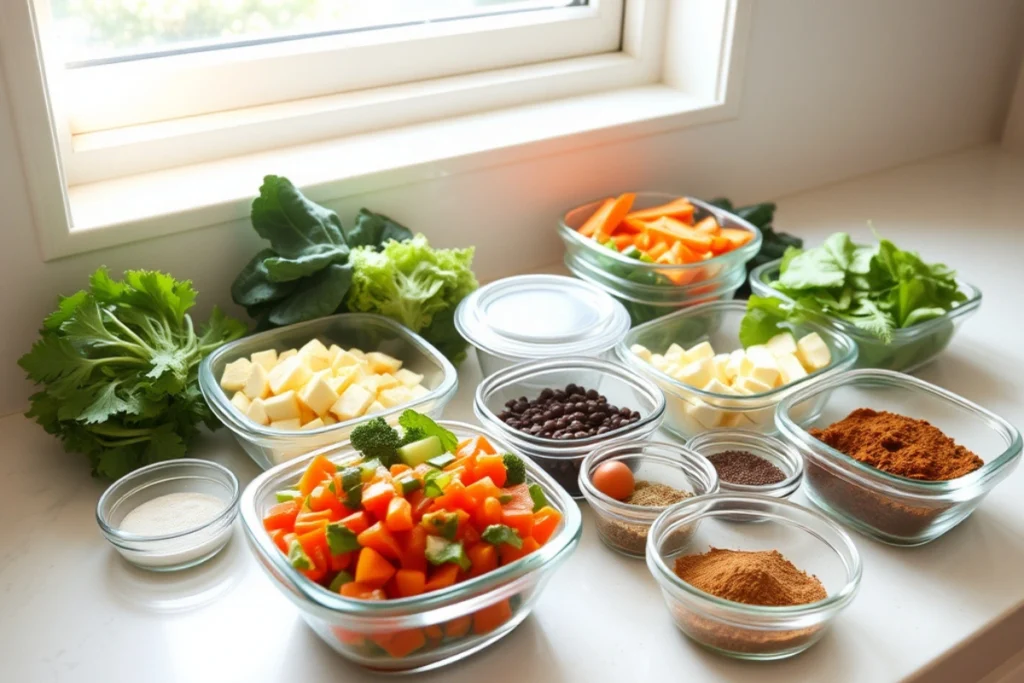INTRODUCTION
Are you curious about low carb vegan recipes and how they can transform your lifestyle? Combining the health benefits of veganism with a low-carb diet is not just a trend. It’s an effective way to improve your health, manage weight, and support sustainability. For those new to this lifestyle, resources like the basic vegan diet guide or the vegan Mediterranean diet guide provide a deeper understanding of how to balance nutrition and make informed choices. In this guide, you’ll find tips, recipes, and insights to help you succeed in this journey.
What are Low Carb Vegan Recipes?
Low carb vegan recipes focus on creating plant-based dishes that are low in carbohydrates. These recipes avoid animal products such as meat, dairy, and eggs. They also limit high-carb foods like grains, sugary snacks, and starchy vegetables. For example, using cauliflower rice or zucchini noodles, like in these vegan cauliflower recipes, makes it easier to enjoy satisfying meals while keeping carb intake low. The result is meals that are nutrient-rich, satisfying, and low in carbs.
Why Choose a Low Carb Vegan Diet?
A low carb vegan diet offers many benefits. It can help with weight management and boost energy levels. This diet also reduces the risk of diseases like diabetes and heart problems. Another great advantage is its sustainability. Plant-based meals are better for the environment because they have a smaller carbon footprint compared to animal products. Eating healthily while caring for the planet has never been easier.
The Basics of Low Carb Vegan Eating
Understanding Low Carb Vegan Nutrition
A successful low carb vegan diet begins with understanding its nutritional foundations. It’s essential to focus on balancing macronutrients to ensure you get enough energy and nourishment while keeping carbs low. Let’s break it down into key components for clarity.
Macronutrients in a Low Carb Vegan Diet
Carbohydrates: What to Avoid and What to Include
Not all carbs are created equal. High-carb foods like rice, bread, and potatoes should be limited. Instead, opt for low-carb alternatives such as leafy greens, broccoli, and zucchini. These vegetables are nutrient-rich and provide fiber without spiking your carbohydrate intake.
Protein Sources for Vegans
Getting enough protein on a vegan diet is entirely possible. Focus on options like tofu, tempeh, and edamame. Legumes, such as lentils and chickpeas, are also great sources, but they should be consumed in moderation due to their higher carb content.
Healthy Fats and Their Importance
Fats are a vital part of a low carb vegan diet. Foods like avocados, nuts, seeds, and coconut oil are excellent choices. They provide energy, help with nutrient absorption, and keep you feeling full longer.
Common Ingredients in Low Carb Vegan Recipes
Building a pantry with the right ingredients is crucial for this lifestyle. Here are some staples to include:
- Low-carb vegetables: Spinach, kale, cauliflower, mushrooms, and asparagus.
- Plant-based proteins: Tofu, tempeh, and seitan.
- Healthy fats: Almonds, chia seeds, flaxseeds, and olive oil.
- Low-carb substitutes: Cauliflower rice, zucchini noodles, and almond flour for baking.
These ingredients will make your meal preparation easier and more versatile.
Top Low Carb Vegan Recipes
Eating low carb and vegan doesn’t mean sacrificing flavor or creativity in the kitchen. Here are some of the best recipes to try, covering everything from breakfast to snacks and desserts. Each recipe is easy to follow, packed with nutrients, and sure to please your taste buds.

Breakfast Recipes
Avocado and Spinach Smoothie Bowl
Ingredients:
- 1 ripe avocado
- 1 cup fresh spinach
- 1 cup unsweetened almond milk
- 1 tablespoon chia seeds
- 1 tablespoon peanut butter (unsweetened)
- Ice cubes (optional)
Instructions:
- Combine all ingredients in a blender.
- Blend until smooth and creamy.
- Pour into a bowl and top with a sprinkle of chia seeds, shredded coconut, or a handful of fresh berries.
Nutritional Content (per 100g):
| Nutrition | Amount |
|---|---|
| Calories | 120 |
| Carbohydrates | 5 g |
| Protein | 3 g |
| Fat | 10 g |
| Fiber | 4 g |
Almond Flour Pancakes with Berries
Ingredients:
- 1 cup almond flour
- 1 tablespoon flaxseed meal
- 1/2 teaspoon baking powder
- 1/2 cup unsweetened almond milk
- 1 teaspoon vanilla extract
- Fresh berries for topping
Instructions:
- Mix almond flour, flaxseed meal, and baking powder in a bowl.
- Gradually add almond milk and vanilla extract. Stir until you get a smooth batter.
- Heat a non-stick pan over medium heat.
- Pour small amounts of batter onto the pan to form pancakes. Cook for 2-3 minutes on each side.
- Serve with fresh berries and a drizzle of sugar-free syrup if desired.
Nutritional Content (per 100g):
| Nutrition | Amount |
|---|---|
| Calories | 140 |
| Carbohydrates | 4 g |
| Protein | 6 g |
| Fat | 11 g |
| Fiber | 2 g |
Lunch Recipes
Cauliflower Rice Sushi Rolls
Ingredients:
- 1 head of cauliflower, riced
- 4 sheets of nori
- 1 avocado, sliced
- 1 cucumber, julienned
- 1 cup shredded carrots
- Soy sauce or tamari for dipping
Instructions:
- Cook the cauliflower rice in a non-stick pan for 5 minutes to soften it. Let it cool.
- Lay a nori sheet on a sushi mat. Spread a thin layer of cauliflower rice over it, leaving a small border at the top.
- Add avocado, cucumber, and carrots in a row at the bottom of the sheet.
- Roll tightly, using the mat for support. Seal the edge with a bit of water.
- Slice into bite-sized pieces and serve with soy sauce or tamari.
Nutritional Content (per 100g):
| Nutrition | Amount |
|---|---|
| Calories | 80 |
| Carbohydrates | 6 g |
| Protein | 2 g |
| Fat | 5 g |
| Fiber | 3 g |
Tips for Following a Low Carb Vegan Diet
Adopting a low carb vegan diet can feel challenging at first, but with the right strategies, it becomes an enjoyable and sustainable lifestyle. These tips will help you plan, shop, and stick to your goals while avoiding common pitfalls.
How to Plan Your Meals
Meal planning is a game-changer for staying consistent with your diet. Start by creating a weekly meal plan that includes a variety of low carb vegan recipes. Choose dishes that are easy to prepare and incorporate seasonal ingredients. This approach saves time, reduces food waste, and keeps you from resorting to unhealthy options. Prep your meals in advance by chopping vegetables, cooking proteins like tofu, and storing individual servings in airtight containers. Having meals ready to grab makes it easier to stick to your plan.
Shopping Guide for Low Carb Vegan Ingredients
Grocery shopping for a low carb vegan lifestyle can be straightforward if you know what to look for. Focus on whole foods that are nutrient-dense and low in carbs. Here’s a simple guide:
- Vegetables: Stock up on low-carb veggies like spinach, kale, zucchini, broccoli, and bell peppers.
- Proteins: Look for tofu, tempeh, and edamame, which are rich in protein and versatile in recipes.
- Fats: Include avocado, coconut oil, nuts, and seeds for healthy fat sources.
- Alternatives: Use almond or coconut flour for baking and cauliflower rice or zucchini noodles as substitutes for high-carb options.
If you’re shopping online, check out the product labels carefully to ensure they align with your dietary needs. Many health stores also have dedicated vegan or low-carb sections to simplify your search.
Avoiding Common Mistakes
Starting a low carb vegan diet without proper knowledge can lead to frustration. Avoid these common mistakes to stay on track:
- Not eating enough calories: Plant-based foods tend to be less calorie-dense than animal products. Ensure your meals contain enough fats and proteins to meet your energy needs.
- Over-relying on processed foods: While vegan substitutes like mock meats can be convenient, they’re often high in carbs and additives. Stick to whole, minimally processed foods whenever possible.
- Skipping variety: Eating the same few dishes can lead to boredom. Experiment with different spices, cuisines, and cooking techniques to keep things exciting.
How to Stay Motivated
Motivation can fluctuate, but having clear goals will help you stay committed. Surround yourself with supportive communities, such as online forums or social media groups, to share your journey and find inspiration. Celebrate small wins, like trying a new recipe or hitting a milestone, to keep your enthusiasm alive. Remember, focusing on how this diet improves your health and aligns with your values can reinforce your commitment.
Health Benefits of Low Carb Vegan Diets
A low carb vegan diet offers an impressive range of health benefits. From weight management to increasing energy, this lifestyle can make a significant difference in your overall well-being. Let’s take a closer look at why this diet is so effective.
Benefits for Weight Loss
One of the most noticeable benefits of a low carb vegan diet is weight loss. By reducing high-carb foods like bread, pasta, and sugary snacks, your body uses stored fat for energy. This process, often called ketosis, helps you shed extra pounds. Moreover, plant-based proteins and healthy fats—such as tofu, avocado, and nuts—keep you feeling full longer, making it easier to eat less overall.
Interestingly, studies have shown that diets low in carbs and high in whole foods improve metabolism. This doesn’t just lead to weight loss but also better control of blood sugar, which is especially important for people managing diabetes.
Improved Energy Levels
A low carb vegan diet can also boost your energy levels. Because these meals stabilize blood sugar levels, you’re less likely to experience energy crashes during the day. For instance, foods like spinach, almonds, and seeds provide a steady supply of nutrients. They prevent the ups and downs caused by sugary snacks or processed carbs.
Additionally, balanced meals with protein, fiber, and healthy fats help your body stay energized for longer periods. As a result, you’ll feel more alert and focused throughout your daily activities.
Reduced Risk of Chronic Diseases
Another significant benefit of this diet is its ability to lower the risk of chronic illnesses. Let’s explore how:
- Diabetes Prevention: By cutting out high-carb and sugary foods, you stabilize blood sugar levels. This can prevent type 2 diabetes or help manage it more effectively.
- Better Heart Health: Plant-based foods are naturally low in cholesterol and unhealthy fats. Adding heart-friendly options like walnuts and flaxseeds enhances this benefit, reducing the risk of heart disease.
- Cancer Protection: Low-carb vegetables like broccoli and cauliflower contain antioxidants that fight inflammation. These nutrients may also lower the risk of certain cancers.
By focusing on whole, plant-based foods, you not only nourish your body but also reduce the risk of long-term health issues. For many, this combination of benefits makes the low carb vegan diet an easy choice.
Common Misconceptions About Low Carb Vegan Recipes
Although low carb vegan recipes are gaining popularity, there are still several misconceptions about this lifestyle. These myths often discourage people from exploring its benefits. Let’s bust some of the most common myths and provide clarity.
Myth 1: Low Carb Vegan Recipes Lack Flavor
Many people believe that low carb vegan dishes are bland or boring. However, this couldn’t be further from the truth. By using fresh herbs, spices, and creative cooking techniques, these recipes can be packed with flavor. For instance, a simple zucchini noodle stir-fry can become extraordinary with garlic, ginger, and soy sauce. Additionally, ingredients like nutritional yeast and tahini add a rich, cheesy flavor without needing dairy.
Myth 2: It’s Difficult to Get Enough Protein
Another common misconception is that it’s hard to get sufficient protein on a low carb vegan diet. In reality, there are plenty of plant-based protein options. Foods like tofu, tempeh, seitan, and edamame are protein-rich and versatile. For example, tempeh can be grilled, stir-fried, or marinated to create a delicious meal. Adding chia seeds, hemp seeds, or almond butter to your diet also boosts protein intake. With a little planning, meeting your protein needs is completely achievable.
Myth 3: Low Carb Vegan Diets Are Too Restrictive
Some assume this diet is overly restrictive because it excludes both animal products and high-carb foods. While it does involve certain limitations, there is still an abundance of food choices. Low-carb vegetables, nuts, seeds, healthy oils, and plant-based proteins allow for diverse and satisfying meals. For instance, a cauliflower crust pizza topped with vegan cheese and veggies can easily satisfy cravings. Additionally, experimenting with international cuisines like Thai or Mediterranean can keep your meals exciting.
Myth 4: It’s Too Expensive
Many people worry that maintaining a low carb vegan diet will strain their budget. While certain specialty items like almond flour or vegan cheeses can be costly, the core of this diet is built on affordable ingredients. Fresh vegetables, tofu, and legumes are often cheaper than meat and processed foods. Planning meals and buying in bulk can further reduce costs, making this diet accessible to most budgets.
By addressing these misconceptions, it’s clear that low carb vegan recipes are flavorful, nutritious, and accessible to anyone willing to give them a try.
FAQs About Low Carb Vegan Recipes
Understanding a low carb vegan diet often brings up several questions. Below are answers to some of the most frequently asked ones to help guide you along the way.
Are Low Carb Vegan Recipes Suitable for Beginners?
Yes, low carb vegan recipes are perfectly suitable for beginners. To start, focus on simple, whole-food-based meals like zucchini noodles or cauliflower rice stir-fries. These dishes are easy to prepare and require only a handful of ingredients. Additionally, for those new to veganism, the basic vegan diet guide offers an excellent foundation.
Can You Build Muscle on a Low Carb Vegan Diet?
Building muscle on a low carb vegan diet is absolutely achievable. By prioritizing high-protein, low-carb foods such as tofu, tempeh, and hemp seeds, you can meet your protein needs. Furthermore, pairing these foods with strength training exercises helps promote muscle growth. For variety, recipes highlighted in the vegan Mediterranean diet guide can provide nutrient-packed meal ideas to support recovery.
How Do I Ensure Proper Nutrition on a Low Carb Vegan Diet?
Ensuring proper nutrition requires focusing on nutrient-rich foods. For example, including leafy greens, low-carb vegetables, and protein-packed options like seitan can help maintain balance. Additionally, supplements like vitamin B12 and omega-3 are beneficial to fill potential gaps in your diet. Moreover, you can find recipes in the vegan gluten-free recipes guide that align well with low-carb principles and dietary needs.
Are Low Carb Vegan Recipes Expensive?
Low carb vegan recipes don’t necessarily have to be expensive. For instance, core ingredients like vegetables, seeds, and tofu are generally affordable. Furthermore, buying items like nuts or almond flour in bulk can significantly reduce costs over time. Proper planning is key to keeping this diet within a manageable budget.
Can I Follow This Diet While Dining Out?
Following a low carb vegan diet while dining out is certainly possible. For example, many restaurants are flexible and allow you to customize dishes. Opting for salads or veggie-based meals and replacing high-carb sides with extra vegetables are practical strategies. Additionally, meal ideas like those found in the vegan casseroles for dinner guide can inspire easy, satisfying meals at home too.
Embracing Low Carb Vegan Recipes
Choosing a low carb vegan diet is more than just a dietary decision—it’s a commitment to a healthier, more sustainable lifestyle. By combining the benefits of reducing carbohydrates with the ethical and environmental advantages of veganism, this approach offers a holistic way to improve your well-being.
Recap of Key Points
Throughout this guide, we’ve explored the foundations of a low carb vegan lifestyle, covering essential tips, common myths, and frequently asked questions. You’ve also discovered delicious recipes, such as cauliflower rice sushi rolls and almond flour pancakes, which demonstrate how versatile and flavorful this diet can be. Furthermore, resources like the vegan Mediterranean diet guide and vegan casserole recipes for dinner provide additional inspiration for maintaining variety and balance.
Steps to Get Started
Starting your journey doesn’t have to be overwhelming. Begin by stocking your kitchen with essential ingredients like low-carb vegetables, plant-based proteins, and healthy fats. Planning meals in advance ensures you have nourishing options readily available, whether it’s a busy weekday or a relaxing weekend. Additionally, incorporating recipes from trusted sources can help you stay on track while enjoying diverse flavors.
A Lifestyle with Benefits
Adopting this lifestyle goes beyond weight loss or dietary preferences. It’s a step towards reducing your environmental footprint and aligning your meals with a plant-based philosophy. By focusing on nutrient-dense, whole foods, you can boost energy levels, support long-term health, and contribute to a more sustainable world.
With determination and an open mind, the journey to embracing low carb vegan recipes can be incredibly rewarding. Small changes in your daily habits can lead to big improvements in your overall well-being. Let this guide be your starting point, and see how this lifestyle can transform not just your plate but also your perspective.

